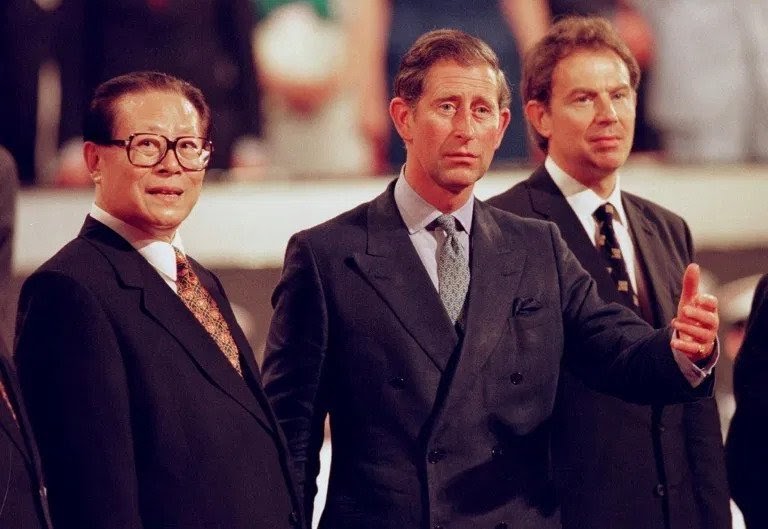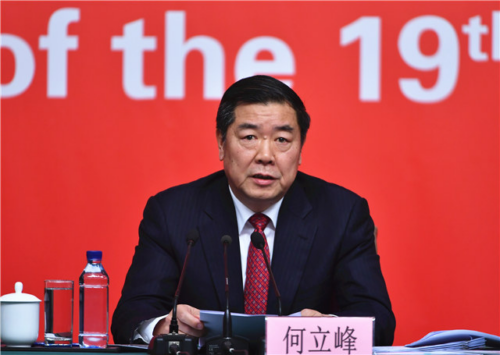This Week in China’s History: June 30 / July 1, 1997
“We shall not forget you, and we shall watch with the closest interest as you embark on this new era of your remarkable history.” Charles, Prince of Wales, spoke these words at the ceremony marking Hong Kong’s transition from British to Chinese sovereignty at midnight on July 1, 1997. In this new era, as part of the People’s Republic of China under the “one country, two systems” formula laid out in the Basic Law, the new Special Administrative Region was promised a “high degree of autonomy” and that “the previous capitalist system and way of life shall remain unchanged for 50 years.”
It appears that those 50 years ran out early, with the implementation of a new National Security Law that places Hong Kong under most of the same rules regarding speech and assembly that govern the rest of the People’s Republic — and seems to betray the commitment to autonomy Prince Charles referred to. This — along with the momentous changes that have taken place in Hong Kong recently, accelerating over the last year or so — is an obvious focus for this week’s column. But before looking at 1997 and the end of British sovereignty, let’s go back to the mid-19th century, to a pair of events that mark its beginning.
The first was in 1839. Villages in and around today’s Hong Kong had long been oriented toward the sea, both for fishing and for trade. By the 1820s, many of them served as regular ports of call for European vessels making their way to trade at Macau, the Portuguese enclave established in the 1500s, and Guangzhou (Canton), the only Chinese port opened to trade at the time. British traders established (illegal) bases for trading opium in and around Hong Kong in the 1820s, and as early as 1834, British authorities suggested the idea of Hong Kong as a possible center for British interests in the region.

The process that would lead to Hong Kong becoming a British colony accelerated in 1839, when Qing commissioner Lín Zéxú 林则徐 seized opium stores at Guangzhou. While British officials and traders waited to see how their government would respond, local conditions got out front of international diplomacy. On July 12, a group of British sailors landed at the village of Tsim Sha Tsui — now an important commercial district in Kowloon — and, along with some Americans, went in search of liquor. They succeeded, sating themself on samshu, a rice-liqueur fortified for good measure with arsenic. Emboldened and belligerent, the sailors brawled their way home, and on the way killed a Chinese local named Lin Weixi. Lin can be called the first casualty of the Opium War.
For several months, Qing authorities demanded justice for the murdered man while British officials offered hush money and muted apologies, a negotiation Julia Lovell describes vividly in her book, The Opium War. Losing patience, the Qing cut off food supplies to the British ships moored in the waters surrounding Hong Kong and Macao. Weeks of negotiations led to the first battle of the war — the Battle of Kowloon — in September. For three years, China and Britain fought: on land, the battles were often bitter, but at sea, where the issue was decided, Britain had a clear advantage, including an ironclad, steam-powered warship, the Nemesis.
We see here how Hong Kong was intimately bound to the start of the Opium War, but it was that war’s end, on June 26, 1843, that fundamentally shaped Hong Kong’s future. This is the second — along with Lin Weixi’s murder in July — of the two 19th-century anniversaries that altered Hong Kong, when the Treaty of Nanjing took effect and formally ceded sovereignty of the city over to Great Britain ”in perpetuity,” part of a raft of treaties signed in the mid-1840s. Along with the colonization of Hong Kong, the treaties opened five ports to trade, and enabled citizens of signatory nations to live in China subject, largely, to their own laws under a principle called “extraterritoriality.”
Hong Kong’s prosperous future was not yet evident, and many in Britain felt that the war should have yielded a greater prize. Lord Palmerston, the Foreign Secretary, called the new territory “a barren rock with nary a house upon it. It will never be a mart for trade,” but the colony took hold. In 1860, a second treaty (negotiated after another war) gave Britain additional territory, including its first piece of the Chinese mainland: the Kowloon peninsula as far as today’s Boundary Street.
Both of these concessions were made “in perpetuity.” There was no suggestion that this would be returned to China. How, then, did we get to the 1997 handover that occasioned this column?
That deadline came from a third addition to Hong Kong, one that arose out of an 1898 arrangement to lease the New Territories (still so-named, though no longer very new) for 99 years. These New Territories formed almost 90% of the area of the colony that was handed over in 1997, mostly on the mainland, but also about 200 islands, including Lantau, the largest in the territory.
The 99-year lease was part of a renewed wave of imperialism that saw Germany, Russia, and France lease parts of China. The lease was seen as a compromise between Qing officials who wanted to resist expansion of the colony and British desire for expansion of the colonial territory outright. Given the current wave of protest, and the thread of nostalgia for British rule, it’s worth noting that the people of the New Territories resisted the British assumption of sovereignty (coincidentally, for the purposes of “this week in history,” concluded on July 1, 1898). Many of the local civil and military leaders objected to their transfer from the Qing empire to the British one, and organized armed resistance — though it subsided quickly by the time British forces took actual control of the area in April 1899, as detailed in John M. Carroll’s A Concise History of Hong Kong.
Hong Kong thus began the 20th century with its borders defined, and growing into its role as a way station and hiding place on China periphery — Kāng Yǒuwéi 康有为, one of the leaders of the 100 Days’ Reforms I wrote about last week, fled there to escape revolution. The colony really found its stride after World War II and the Chinese Civil War, when people and money from the mainland, especially Shanghai, flowed there. The connection between Shanghai and Hong Kong, forged amid the Opium War and developed as colonial rivals, strengthened in the post-war period, showing the cities’ linked, if not always shared, fortunes. Hong Kong boomed, and more often than not the mainland government paid it little attention, until the reform and opening period began in the late 1970s.
Some in Hong Kong and in Britain clung to hope that the colony might retain its status after the 99-year lease on the New Territories expired, but when Dèng Xiǎopíng 邓小平 rejected Hong Kong governor Maclehose’s 1979 proposal to put aside the 1997 deadline, there was little question that Hong Kong would revert to China. Hong Kong Island and Kowloon were too interdependent with the New Territories to exist on their own, and the optics of British rule on Chinese territory were intolerable to China’s rulers. Two years of negotiation led to a Sino-British Joint Declaration, laying down the process by which Hong Kong would revert to Chinese sovereignty. Key points included the famous “one country, two systems” formula and the promise that Hong Kong would retain its “capitalist system” and “way of life” until, at least, July 1, 2047.
At sundown on the last day of British sovereignty over Hong Kong, Prince Charles stood in a heavy rain and addressed the British garrison as the colors were struck for the final time, water streaming off the bill of his naval officer’s cap. Predictions about the future were everywhere, but visibility in the rain was just a few yards, let alone 50 years. It was a few hours later — indoors — that Charles made his last speech, promising “we shall not forget you.”
At midnight, the Union Flag was lowered and the PRC flag raised. Immediately afterward, CPC General Secretary Jiāng Zémín 江泽民 affirmed for the gathered crowd that “Hong Kong will, in accordance with the Basic Law, develop democracy gradually with the ultimate aim of electing the chief executive and the Legislative Council by universal suffrage…From now on, the Hong Kong compatriots will truly become masters here as a new leaf will be turned in the annals of Hong Kong.”
This assertion is thrown into stark relief now as, for instance, prominent voices of dissent in Hong Kong delete their Twitter accounts and opposition parties like Demosisto cease operations in anticipation of the new security law coming into effect. For the first time, protests using the July 1 handover anniversary to call the Hong Kong and Beijing governments to account are banned.
Anniversaries are often moments to evaluate promises, and so, on this 23rd anniversary of Hong Kong’s handover, we can ask: Have the people of Hong Kong been forgotten, as Prince Charles promised they would not be? And in Jiang Zemin’s words, have the people of Hong Kong “truly become masters”?
This Week in China’s History is a weekly column. Last week:
When China’s reformers believed anything was possible: 100 days in 1898






